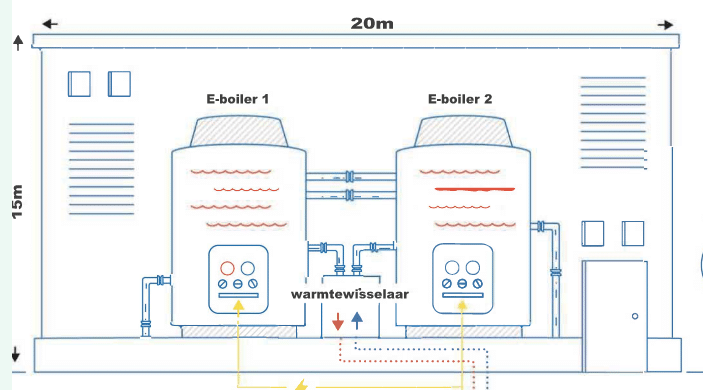Swedish energy company Vattenfall has announced it has secured a building permit and subsidies granted by the Dutch government under the SDE+ program, for a 150 MW electric boiler planned to be located at an existing gas power plant in Diemen, near Amsterdam.
“The final investment decision is scheduled for mid-2022, after the recently initiated tender has been completed,” the company said in a statement.
The huge boiler, which Vattenfall described as a sort of kettle, will convert electricity into heat and supply water to households in Amsterdam and its surrounding areas. “The E-boiler only switches on if the electricity mix is sustainable, with a lot of electricity from solar and wind,” the company said, without specifying the threshold of solar and wind production above which the mix would be considered sustainable. “When there is insufficient green energy, the gas-fired power plants in Diemen are still needed to produce electricity – power plants that also supply heat very efficiently.”
The boiler will also be able to store heat in a special buffer included in its design, which the company described as a large thermal flask. “In this way, we prevent additional use of the installations [of] natural gas and, therefore, unnecessary emissions of CO2 and nitrogen,” Vattenfall further explained. The heat buffer is 50 meters high, 26 meters wide, and has a volume of 22,000m3. Hot water up to 125 degrees Celsius can be stored there under pressure and then used for district heating.
The dimensions of the boiler building are approximately 20x30m and the maximum height of the building will be approximately 15m. One E-boiler will have a diameter of approximately 3.5m and a height of 6.5m. The building will have room for three e-boilers.
The electric boiler should supply approximately 15% of the heat in the Amsterdam region, according to the Swedish group. “However, the number of hours that the E-boiler can run will increase in the coming years, given the growth in the number of wind and solar farms in the Netherlands,” it further explained, noting that the facility may also provide support to the electricity grid by keeping the supply and demand of electricity in balance.
Several attempts are currently being made in the Netherlands to link excess solar and wind power with heating applications. The Dutch association of national and regional electricity and gas network operators, Netbeheer Nederland, is leading a plan to deploy up to 2 million hybrid heat pumps by 2030.
Furthermore, Dutch transmission system operator Tennet, which also serves Germany, said in January, it was planning to create flexible electricity demand and reduce grid congestion by promoting the use of smarter heating systems and heat pumps that can also be powered by solar and wind energy.
This content is protected by copyright and may not be reused. If you want to cooperate with us and would like to reuse some of our content, please contact: editors@pv-magazine.com.




By submitting this form you agree to pv magazine using your data for the purposes of publishing your comment.
Your personal data will only be disclosed or otherwise transmitted to third parties for the purposes of spam filtering or if this is necessary for technical maintenance of the website. Any other transfer to third parties will not take place unless this is justified on the basis of applicable data protection regulations or if pv magazine is legally obliged to do so.
You may revoke this consent at any time with effect for the future, in which case your personal data will be deleted immediately. Otherwise, your data will be deleted if pv magazine has processed your request or the purpose of data storage is fulfilled.
Further information on data privacy can be found in our Data Protection Policy.